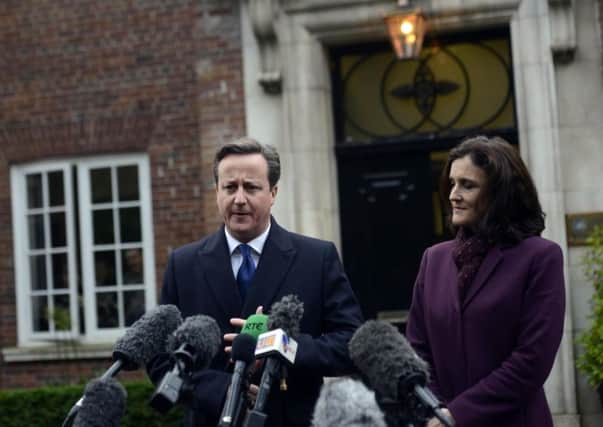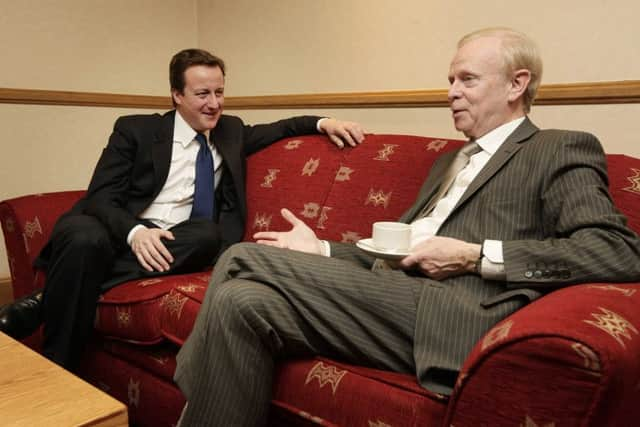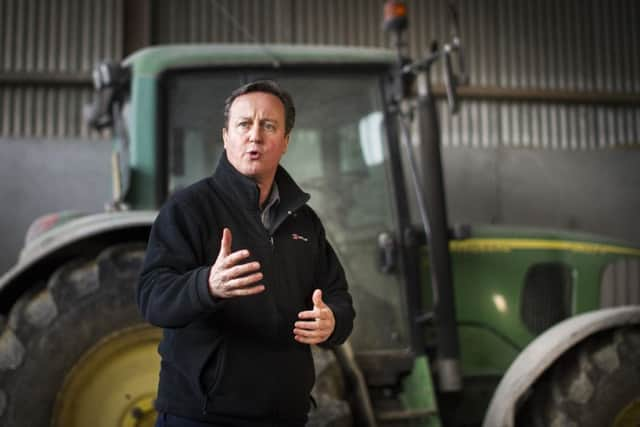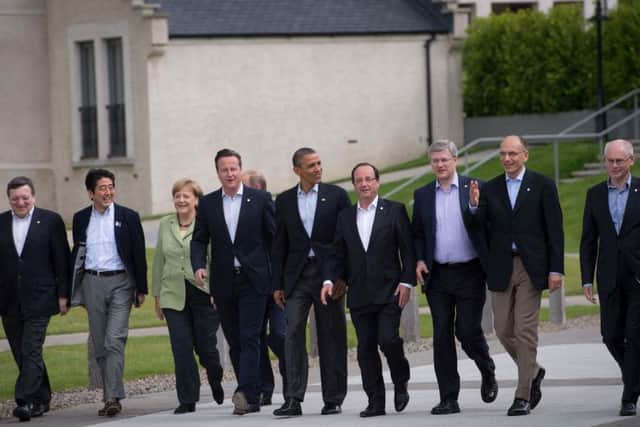Sam McBride: Cameron's stance on NI caused consternation - but made Stormont more stable


Both of those conscious breaks with the past would shape his legacy in the Province.
In June 2010 – just a month after he had led the Conservatives into a coalition government – the new Prime Minister was in Downing Street when he was presented with a copy of the Saville Report into Bloody Sunday.
Advertisement
Hide AdAdvertisement
Hide AdThe Conservatives had been hugely critical of the length and cost of an inquiry which had been set up by Tony Blair a decade earlier and there were many ex-military figures on the Tory benches, few of whom were enthusiastic about the exercise.


One of those who was in Downing Street with the Prime Minister that night – just hours before Mr Cameron was to present the report’s findings to the Commons – told me that Mr Cameron had been presented with a draft speech which was far more equivocal than that which he was to deliver.
Mr Cameron, it is said, was so personally shocked by the strength of the report’s findings that British soldiers had essentially run amok in Londonderry and killed innocent people that he insisted on radically changing the content of what had been prepared for him to say.
In what would be a seminal moment for the new Prime Minister, Mr Cameron solemnly told a hushed Commons chamber: “I am deeply patriotic; I never want to believe anything bad about our country... But the conclusions of this report are absolutely clear: there is no doubt; there is nothing equivocal; there are no ambiguities. What happened on Bloody Sunday was both unjustified and unjustifiable. It was wrong.”
Advertisement
Hide AdAdvertisement
Hide AdHis words were so unequivocal and unexpected that nationalists in Londonderry watching proceedings on a big screen in the centre of the city found themselves roaring on a Conservative Prime Minister.


Four months later, Mr Cameron again made a conscious decision to disregard official advice on Northern Ireland affairs and plotted an alternative course which has contributed to driving the DUP and Sinn Fein closer together than ever before.
Having watched how Tony Blair and Gordon Brown inevitably agreed to meet Stormont’s leaders in Downing Street whenever the latest crisis emerged in Belfast and therefore themselves become embroiled in unionist-nationalist disputes, Mr Cameron resolved to adopt a much firmer position.
His views were articulated through his first Secretary of State for Northern Ireland, Owen Paterson, through aides, and occasionally by himself: If he’d wanted to deal with Northern Ireland matters on a day to day basis, he would have appointed himself to be Northern Ireland Secretary; instead he had appointed Mr Paterson and Stormont’s leaders should deal with him.
Advertisement
Hide AdAdvertisement
Hide AdExacerbated by the fact that Mr Cameron had just fought an election campaign in coalition with their Ulster Unionist rivals, the DUP and Sinn Fein were indignant at the new policy and demanded to meet the Prime Minister.


The pressure from Stormont’s two main parties grew over the summer of 2010 and came to a head after the October Spending Review in which Chancellor George Osborne set out how Stormont’s budget was going to shrink as he attempted to cut the deficit.
Peter Robinson and Martin McGuinness insisted that they must meet the Prime Minister to protest at the cuts and publicly threatened to invoke an obscure dispute resolution mechanism to force a meeting.
An NIO which had successfully pushed forward the peace process and which had been used to facilitating Northern Ireland’s leaders in order to do so was quietly horrified at the new stance from Downing Street.
Advertisement
Hide AdAdvertisement
Hide AdSenior NIO officials advised the Prime Minister to soften his stance and meet the two men. Mr Cameron declined the advice and Stormont’s leaders gradually came to accept that their budget had been set and they would not be able to overturn it.


When it came to Northern Ireland – so often an adjunct to British politics – David Cameron might not have been an expert, but he knew his own mind. One source says that although he believed in staying out of the fine detail, “when need be, he’d be very decisive with his interventions in Northern Ireland”.
That confidence that Stormont was far more stable than its leaders claimed led him to repeatedly face down the Executive, and particularly Sinn Fein over its threats about not implementing welfare reform.
Although Mr Cameron did not prove entirely doctrinaire during the dispute with nationalists on welfare reform, and allowed Stormont some flexibility on how the changes operate in Northern Ireland, he was resolute on the core of the dispute: there would be no additional money for welfare in Northern Ireland.
Advertisement
Hide AdAdvertisement
Hide AdHaving been the first putative Prime Minister to campaign in Northern Ireland for more than three decades after re-establishing the Conservative Party’s link with the Ulster Unionists, Mr Cameron came into office with more direct understanding of the Province – even if it was with a clear unionist bias – than many of his predecessors.
If Stormont had fallen apart on his watch, his confidence would have seemed like detached recklessness, but through luck or judgement the various political crises in Belfast ended with minimal input from Downing Street. His approach was so low key that even in major negotiations such as those leading last year’s Fresh Start deal the participants speak of the Prime Minister leaving much of the work to his secretary of state and the NIO.
Despite Mr Cameron left office with Stormont far more stable than when he was elected in 2010 (and he cannot take more than a small part of the credit for that), many people on this side of the Irish Sea still struggle to see his approach as being founded on anything other than indifference.


And yet even if that simplistic interpretation is correct, it is unquestionably the case that the DUP and Sinn Fein are far closer together today than was the case six years ago. One DUP figure familiar with that period says of Mr Cameron’s arm’s-length approach to Stormont that “we didn’t mind that – the difficulty was Sinn Fein getting their heads round that”.
Advertisement
Hide AdAdvertisement
Hide AdAlthough for several years both Mr Robinson and Mr McGuinness protested intermittently about the policy, the consequence of Mr Cameron’s approach forced the DUP to work together on some of their difficult problems, without expecting the Prime Minister to constantly sort out their dilemmas.
Arguably, the parties’ closer alliance has made Stormont more stable and – potentially – more functional.
Mr Cameron was the most instinctively unionist Prime Minister since Margaret Thatcher. After the years where Labour presented itself as a neutral honest broker in Northern Ireland, the reforming Conservative Prime Minister repeatedly declared his personal unionism and advocated that Northern Ireland should be an integral part of that Union.
One demonstration of that was his decision to host the G8 summit in Fermanagh - the most westerly part of the kingdom.
Advertisement
Hide AdAdvertisement
Hide AdBut that was not to say that he was a partisan leader who always adopted the sort of positions which Ulster’s unionist leaders would have adopted, as evidenced by his response to the Bloody Sunday report.
A DUP source says that “on the things we came looking for around parades we got diddly-squat”.
Mr Cameron was neither swaggering nor aggressive in how he wore his unionism, realising the fragility of the Union which he cherished.
Nevertheless, his link – ultimately ill-fated – with the Ulster Unionists ahead of the 2010 General Election did involve a joint manifesto and therefore set the policy tone for his first years in office.
Advertisement
Hide AdAdvertisement
Hide AdUlster Unionist treasurer Mark Cosgrove was heavily involved in the UUP-Conservative link and addressed the Conservative Party conference in 2009 where he reminded the party of the need to ensure that savers in the stricken Presbyterian Mutual Society (PMS) did not become the only British savers to lose money in the 2007 financial crash.
He says that the Prime Minister’s role in ensuring that PMS savers were rescued was “massive”, along with Mr Cameron’s consistent support – despite a reticent Treasury – for the devolution of corporation tax to Stomornt, allowing Northern Ireland to slash the business tax.
One factor which led to consistency in Mr Cameron’s dealings with Northern Ireland was that he only ever appointed two secretaries of state – and backed them rather than allowing the local parties to constantly go over their heads.
And consistency was also provided by Mr Cameron’s warm relationship with Enda Kenny, two centre-right heads of government whose tenures have been almost coterminous and who shared considerable common ground not only on Northern Ireland, but also in Europe.
Advertisement
Hide AdAdvertisement
Hide AdSomeone who has known the Prime Minister for many years says that “for as long as I’ve known him – he first went to Northern Ireland in 1990 because one of his mates was a BBC journalist – he’s had a genuine and long-standing affection for Northern Ireland”.
Even before Brexit came to define David Cameron’s legacy, Northern Ireland would have occupied just a few pages in his biography.
But – with less energy but as much determination as Tony Blair – Mr Cameron has left a distinctive mark on Stormont, and Northern Ireland.